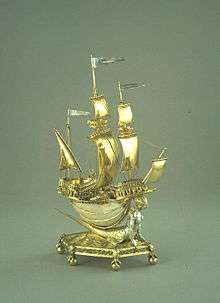Burghley Nef

The Burghley Nef is a silver-gilt salt cellar made in Paris in 1527–28 (or possibly earlier). In medieval France the word nef was applied to various types of boat-shaped containers, including the most magnificent objects intended for the dining tables and buffets of the rich. Apart from having an obvious ornamental quality, their function was to hold personal pieces of cutlery or, as in this case, salt or spices—there is a detachable compartment on the rear deck, which was presumably passed around the table. This nautilus shell, mounted in silver, was a rare natural curiosity.
The Burghley Nef would have been placed in front of the most important person at table as a mark of their status. At the foot of the mast, engaged in a game of chess, are the tiny figures of the lovers Tristan and Iseult who, according to the legend, mistakenly drank a love potion and suffered tragic consequences. The Burghley Nef is currently in the collection of the Victoria and Albert Museum in London. It was discovered at Burghley House in 1956 and sold on 17 July 1959 when the 6th Marquess of Exeter auctioned part of his silver collection.
Bibliography
- Jackson, Anna, ed. (2001). V&A: A Hundred Highlights. Victoria and Albert Museum. ISBN 9781851773657.
External links
![]() Media related to Burghley Nef at Wikimedia Commons
Media related to Burghley Nef at Wikimedia Commons